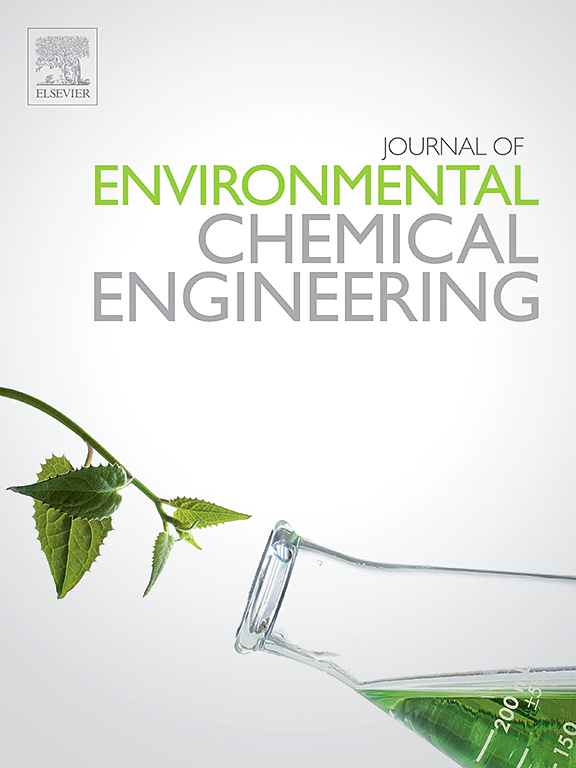Bi2WxMo1-xO6/g-C3N4 z型异质结强化甲醛净化:带结构调控、光生载流子分离和吸附
IF 7.4
2区 工程技术
Q1 ENGINEERING, CHEMICAL
引用次数: 0
摘要
光生成载体易重组和光利用率低的特点阻碍了该方法在光催化降解甲醛(HCHO)中的应用。本文采用水热法合成了3D/2D Bi2WxMo1-xO6/g-C3N4 Z-scheme异质结,用于降解HCHO。与Bi2W0.6Mo0.4O6(38.7 %)和g-C3N4(23.2 %)相比,Bi2W0.6Mo0.4O6/g-C3N4光催化降解甲醛的活性更高(80.4 %),稳定性较好,5次循环后降解效率降低6.3 %。与其他制备的催化剂相比,其光催化性能的提高主要归功于带结构的调节、光生载体的分离以及对HCHO的吸收。随着Mo取代量的增加,Bi2WxMo1-xO6固溶体的带隙从2.79 eV减小到2.22 eV。理论计算结果也证明了光响应范围的扩大。Mo元素明显改变了固溶体的导带最小值。BSS6/g-C3N4 z型异质结有效地促进了光生h+和e-的分离。此外,理论计算表明Mo取代增强了固溶体的吸收。这项工作有助于了解z型异质结与HCHO纯化之间的构效关系。本文章由计算机程序翻译,如有差异,请以英文原文为准。
Enhanced formaldehyde purification via Bi2WxMo1-xO6/g-C3N4 Z-scheme heterojunction: Regulation of band structure, photogenerated carriers separation, and adsorption
The tendency for photogenerated carriers to recombine easily and the low utilization of light hinder the application of this method in the photocatalytic degradation of formaldehyde (HCHO). Herein, 3D/2D Bi2WxMo1-xO6/g-C3N4 Z-scheme heterojunction were synthesized through hydrothermal method for the degradation of HCHO. In contrast to Bi2W0.6Mo0.4O6 (38.7 %) and g-C3N4 (23.2 %), Bi2W0.6Mo0.4O6/g-C3N4 exhibited superior activity (80.4 %) of photocatalytic degradation for formaldehyde and satisfactory stability with 6.3 % decrease in degradation efficiency after five cycles. Enhanced photocatalytic performance compared to the other prepared catalysts was attributed to the regulation of band structure, the separation of photogenerated carriers and the absorption for HCHO. With the increase of Mo substitution, the band gap of Bi2WxMo1-xO6 solid solutions decreased from 2.79 eV to 2.22 eV. Theoretical calculation results also proved the broaden of photo response range. Mo element obviously changed the conduction band minimum of solid solution. BSS6/g-C3N4 Z-scheme heterojunction effectively facilitated the separation of photogenerated h+ and e-. Besides, theoretical calculation revealed that Mo substitution enhanced the absorption of solid solutions. This work was helpful to understand the structure-activity relationship between Z-scheme heterojunction and HCHO purification.
求助全文
通过发布文献求助,成功后即可免费获取论文全文。
去求助
来源期刊

Journal of Environmental Chemical Engineering
Environmental Science-Pollution
CiteScore
11.40
自引率
6.50%
发文量
2017
审稿时长
27 days
期刊介绍:
The Journal of Environmental Chemical Engineering (JECE) serves as a platform for the dissemination of original and innovative research focusing on the advancement of environmentally-friendly, sustainable technologies. JECE emphasizes the transition towards a carbon-neutral circular economy and a self-sufficient bio-based economy. Topics covered include soil, water, wastewater, and air decontamination; pollution monitoring, prevention, and control; advanced analytics, sensors, impact and risk assessment methodologies in environmental chemical engineering; resource recovery (water, nutrients, materials, energy); industrial ecology; valorization of waste streams; waste management (including e-waste); climate-water-energy-food nexus; novel materials for environmental, chemical, and energy applications; sustainability and environmental safety; water digitalization, water data science, and machine learning; process integration and intensification; recent developments in green chemistry for synthesis, catalysis, and energy; and original research on contaminants of emerging concern, persistent chemicals, and priority substances, including microplastics, nanoplastics, nanomaterials, micropollutants, antimicrobial resistance genes, and emerging pathogens (viruses, bacteria, parasites) of environmental significance.
 求助内容:
求助内容: 应助结果提醒方式:
应助结果提醒方式:


